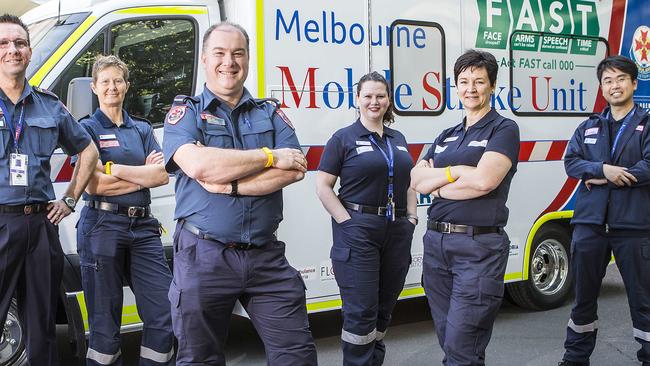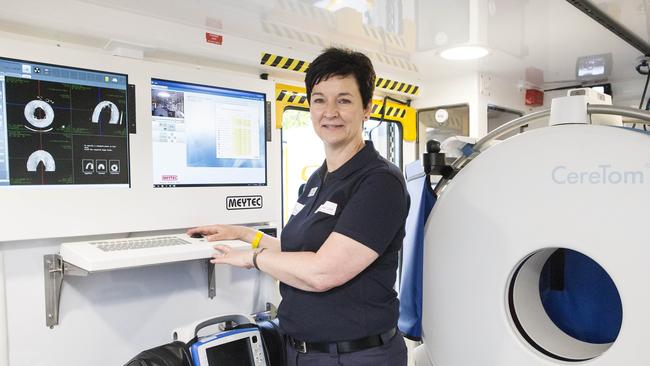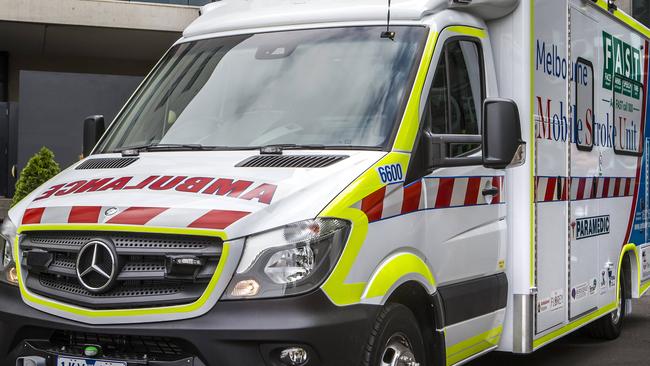Six-year-old boy saves grandpa’s life by noticing signs of stroke
Six-year-old Jackson White’s quick thinking helped put in motion an impressive medical response that helped save his grandfather’s life.
Victoria
Don't miss out on the headlines from Victoria. Followed categories will be added to My News.
It started as a happy event: three generations coming together on a Friday night to celebrate a family birthday.
Jackson White was enjoying some one-on-one time with his grandfather Geoff Chilcott. The eldest of his five grandchildren, Jackson calls him his “Pop C”.
Just after 5pm Jackson was play-fighting with the quietly spoken transport business owner while his mum Sophie and “Nanny Michelle” were busy preparing dinner.
The kindergarten student noticed first that his grandfather had suddenly stopped playing and then saw his Pop C dribbling at the side of his mouth.

Jackson, 6, called out to his mum for help and that helped to save his grandfather’s life.
That, and a unique telemedicine trial Mr Chilcott, 58, had unexpectedly joined.
The trial had started just days earlier and Mr Chilcott would become one of its first patients; later an impressive success story.
Michelle Chilcott knew what was happening. Her husband had suffered a stroke a decade earlier so she was aware of the signs.
A stroke happens when a blood vessel supplying blood to the brain either becomes blocked - known as an ischaemic stroke - or ruptures and begins to bleed - a haemorrhagic stroke. Getting help quickly is critical. Every minute after a stroke means the death of two million brain cells.
Ambulance Victoria was first to arrive at the family home, 40km east of the city. The crew manning the state’s only Mobile Stroke Unit (MSU) at the Royal Melbourne Hospital were also alerted.

The MSU is a unique lifesaver. A fully-equipped, custom-built specialist Ambulance Victoria vehicle run in partnership with the RMH.
Crucially, it has a built-in CT scanner and is operated by a team of acute stroke specialists that includes two paramedics, a CT radiographer, a neurologist and a nurse specialist.
“It is a busy space,” stroke neurologist Dr Henry Zhao says. “But it is a streamlined process and it saves lives.”
He was the neurologist on duty the day Mr Chilcott had his stroke and was part of the telemedicine trial investigating if a neurologist could remain at the hospital and co-ordinate the team remotely.
“If successful, eventually we can be at the hospital and doing other work and we will get notifications when the MSU is called out,” he said.
Dr Zhao says the potential is one neurologist could run multiple vehicles, allowing for the possibility of a service seven days a week. It would also help assess and treat more patients faster; critical when around 7000 Victorians suffer a first stroke every year.

Three minutes after the ambulance crew arrived to help Mr Chilcott they started a telehealth call to Dr Zhao. The radiologist on board also did a scan and Dr Zhao was able to determine the type of stroke, treatment needed in hospital and prescribe Mr Chilcott lifesaving clot dissolving medications as he was en route to the hospital.
“It meant we avoided delays,” Dr Zhao said. “Specifically, we knew the patient would need a surgical procedure called a thrombectomy to remove a blood clot so everything was ready when he arrived.”
Ambulance Victoria Melbourne senior team manager Leigh Branagan said the highly successful MSU had treated thousands of people and changed the outcomes of many Victorians.

Just 48 hours after his stroke, Mr Chilcott was discharged. He is now back home and preparing to return to work.
“I am feeling really good now,” Mr Chilcott said. “I think without Jackson and the ambulance team who knows what the outcome might have been?”
As for Jackson, he says his grandson saved his life. Jackson says he is just happy to have his Pop C home.
Stroke facts:
• Around 7000 Victorians have a first stroke each year; 10 per cent die
• One occurs in Australia every 19 minutes
• 17 per cent are more likely to happen in regional and rural areas





